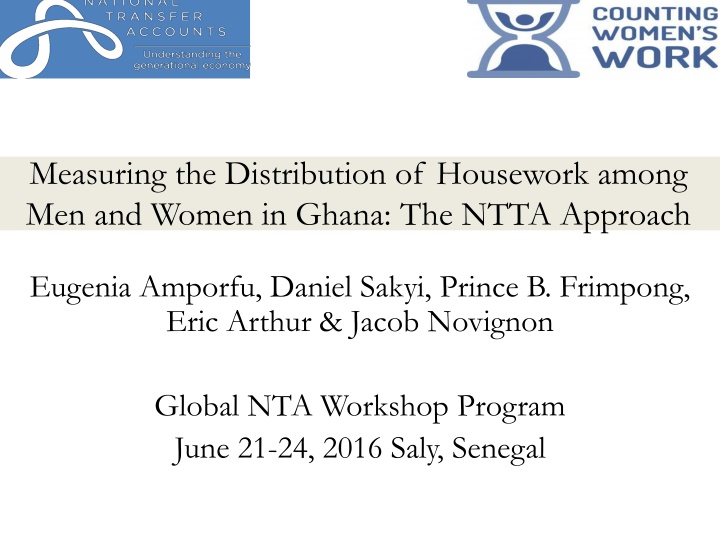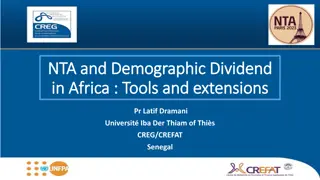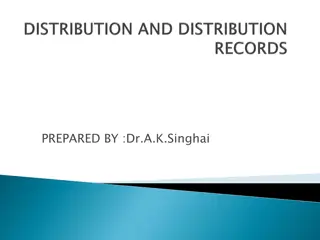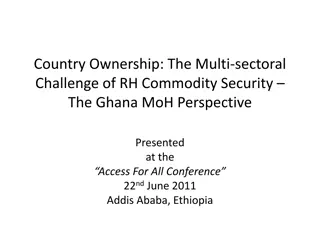Measuring the Distribution of Housework among Men and Women in Ghana: The NTTA Approach
In Ghana, the distribution of housework between men and women is explored using the NTTA approach, highlighting inequalities and time allocation in household activities. The study aims to estimate time spent on housework and market production, comparing differences between genders based on data from a 2009 time use survey.
Download Presentation

Please find below an Image/Link to download the presentation.
The content on the website is provided AS IS for your information and personal use only. It may not be sold, licensed, or shared on other websites without obtaining consent from the author.If you encounter any issues during the download, it is possible that the publisher has removed the file from their server.
You are allowed to download the files provided on this website for personal or commercial use, subject to the condition that they are used lawfully. All files are the property of their respective owners.
The content on the website is provided AS IS for your information and personal use only. It may not be sold, licensed, or shared on other websites without obtaining consent from the author.
E N D
Presentation Transcript
Measuring the Distribution of Housework among Men and Women in Ghana: The NTTA Approach Eugenia Amporfu, Daniel Sakyi, Prince B. Frimpong, Eric Arthur & Jacob Novignon Global NTA Workshop Program June 21-24, 2016 Saly, Senegal
Introduction Inequality (economic and noneconomic) forms possess: Some inherent gender dimensions in the form of gender-differentiated time use (Abdourahman 2010) In most developing countries, gender division of labour has traditionally selected women to specialize in household production activities such as: Cooking and cleaning Caring for children and the elderly
Introduction Share of women in paid employment in 2000 and 2010 in Ghana: 2000 2010 Urban : 30.6% to 33.7% Rural : 29% to 28.5% (GSS 2013) A greater proportion of women in Ghana are engaged in unpaid work
Motivation Traditional measurements of economies only consider: The market economy and remunerated work NTA 2005 results for Ghana indicate: Lifecycle surplus for working-age adults and deficits for dependent age groups (children and elderly) However, NTA suffers the same problems: Non-market services Unclear as to whether the surplus was generated solely by men Significant difference between men and women in terms of: Access to education Access to health Familial and other supports Experiences in the labour market
Objectives Estimate NTA by sex Estimate the amount of time Ghanaian men and women spend on housework Compare time spent on market production for men and women Identify the differences in the time spent by both genders
Data Time use survey 2009: 4,800 households randomly selected from a list of Enumeration Areas Individuals age 10 years and above interviewed 24-hour diary, divided into one-hour slots used as the core instrument to record activities Households interviewed: 4,193; Males interviewed: 4,286; Females interviewed: 5,011 No income and expenditure survey was conducted in 2009: Used minimum daily wage as a proxy for wages for household activities as well as care
Methodology Production Calculate time spent by each individual across activities: Paid work, Learning, Household Activities, Non-household activities (Volunteering), Care Calculate mean time per day for each sex at each age in each activity Smooth profiles Consumption Allocate production of the non-market services to consumers within and outside the household (per capita, regression, rule-based) Transfer inflows and outflows Based on production and consumption
Combining NTA and NTTA data We combined our 2005 NTA estimates with 2009 NTTA estimates by: Inflating all 2005 estimates by growth in per capita GDP This is done not to capture only inflation, but also per capita income
Labour Income & Consumption - Money 5,000 4,500 4,000 3,500 3,000 2,500 2,000 1,500 1,000 500 - 0 10 20 30 40 50 60 70 80 90 Age YL Female YL Male C
NTA Labour Income - Time 60 50 Hours per week 40 30 20 10 - 0 10 20 30 40 50 60 70 80 90 Age YL Female YL Male
NTA Females never generate lifecycle surplus Males generate surplus between ages 27 and 68 years Considering the time version, the difference between males and females is reduced significantly
Time use, Average Person 160 140 Hours Per Week (168 total) 120 100 80 60 40 20 0 0 10 20 30 40 50 60 70 80 90 Age NTTA - care NTTA - housework Edu NTA work Leisure & Self-Care
Time use, Average person - Separated 160 140 Hours per week (168 total) 120 100 80 60 40 20 0 0 10 20 30 40 50 60 70 80 90 Age NTTA - care NTTA - housework NTA work Edu Leisure & Self-Care
Time use over the lifecycle Hours spent on paid work (market production) peaks at age 42 at about 46 hours per week on average Time spent on education decreases progressively from 33 hours per week at age 15 to about 1 hour per week at age 27 and beyond Time spent on household production peaks at age 27 at about 12 hours per week and declines progressively thereafter Hours spend on care increases steeply from age 15 and reaches a peak at age 34 at about 8 hours per week All other activities consume a large proportion of the remaining time: Leisure and personal care
Time Use, Female-Male Differences 20 15 Female dominates 10 5 Hours Per Week - 0 10 20 30 40 50 60 70 80 90 (5) (10) (15) Male dominates (20) (25) Age NTTA - care NTTA - housework Edu NTA work Leisure & Self-Care
Time Use, Female-Male Differences Females dominate in housework over their entire lifecycle Males dominate in NTA work over their entire lifecycle Males spend more time in education than females from ages 15 to 37 Males and females are about the same after age 37 Regarding personal care and leisure, males and females alternate in their dominance: Males dominate in the early ages till age 50 Females generally dominate after age 50
NTTA Time, Care + Housework 50 45 40 35 Hours per week 30 25 20 15 10 5 - 0 10 20 30 40 50 60 70 80 90 Age YL Female YL Male C
Net Time Transfer Females generate a transfer surplus for a significant part of their lives: Girls start generating surpluses at age 10 through to age 73 Men do not generate a surplus at all over their entire age profile
NTTA Time, Care vs. Housework 30 25 Hours per week 20 15 10 5 - 0 10 20 30 40 50 60 70 80 90 Age YL Care Female YL Housework Male YL Care Male C Care YL Housework Female C Housework
Care vs. Housework Females generate care surplus from age 10 to age 68 Peaks twice at ages 27 and 35, producing 12 hours of care per week Males also generate care surplus from age 11 throughout However, females generate a larger surplus No surplus generated by males for housework Significant surplus generated by females Produce 20 hours of housework per week at age 30
NTTA + NTA - Time 80 70 60 Hours per week 50 40 30 20 10 - 0 20 40 60 80 Age YL Female YL Male
NTTA + NTA - Money 5,000 4,500 4,000 Billion Ghana Cedi 3,500 3,000 2,500 2,000 1,500 1,000 500 - 0 10 20 30 40 50 60 70 80 90 Age YL Female YL Male C
Household and market production In monetary terms, males generate a lifecycle surplus: Males specialise in market production At the peak age of 41, they spend 60 hours per week on productive activities Females spend more time on total productive activities: Females specialise in household production At the peak age of 35, they spend 67 hours per week on productive activities
Concluding remarks Significant differences between gender regarding the time spent on different activities (i.e., household vs. market) Women specialise in household production Men specialise in market production Overall, women spend more time on productive activities than men: Implication: Significant undervaluation of GDP Implication for labour market
Implications Efficiency Women have inbuilt human capital for housework Men have not tapped into what they have Equity Power sharing Women could be exposed to poverty
Next steps Value household production By relating it to GDP Estimate urban-rural differences in the time spent on household activities Consider exploring other possibilities such as estimating: NTTA by number of children NTTA by level of education
Acknowledgements This research has been made possible by Counting Women s Work , a project sponsored by the International Development Research Centre (IDRC), Canada, and the William and Flora Hewlett Foundation. Gretchen Donehower for her immense assistance We are also greatly indebted to Joze Sambt and Ana eme for their insightful comments and having time to review our codes We also thank Morne Oosthuizen for sharing the South African do file for more guidance























